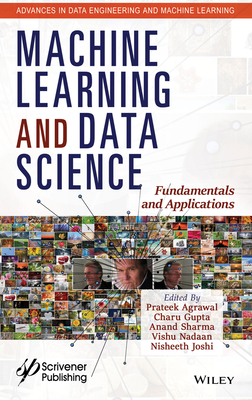Machine Learning for Signal Processing: Data Science, Algorithms, and Computational Statistics (Hardcover)
暫譯: 信號處理的機器學習:數據科學、算法與計算統計 (精裝版)
Little, Max A.
- 出版商: Oxford University
- 出版日期: 2019-10-13
- 售價: $1,680
- 貴賓價: 9.8 折 $1,646
- 語言: 英文
- 頁數: 384
- 裝訂: Hardcover - also called cloth, retail trade, or trade
- ISBN: 0198714939
- ISBN-13: 9780198714934
-
相關分類:
Machine Learning
-
相關翻譯:
面向信號處理的機器學習 (簡中版)
立即出貨 (庫存=1)
買這商品的人也買了...
相關主題
商品描述
This book describes in detail the fundamental mathematics and algorithms of machine learning (an example of artificial intelligence) and signal processing, two of the most important and exciting technologies in the modern information economy. Taking a gradual approach, it builds up concepts in a solid, step-by-step fashion so that the ideas and algorithms can be implemented in practical software applications.
Digital signal processing (DSP) is one of the 'foundational' engineering topics of the modern world, without which technologies such the mobile phone, television, CD and MP3 players, WiFi and radar, would not be possible. A relative newcomer by comparison, statistical machine learning is the theoretical backbone of exciting technologies such as automatic techniques for car registration plate recognition, speech recognition, stock market prediction, defect detection on assembly lines, robot guidance, and autonomous car navigation. Statistical machine learning exploits the analogy between intelligent information processing in biological brains and sophisticated statistical modelling and inference.
DSP and statistical machine learning are of such wide importance to the knowledge economy that both have undergone rapid changes and seen radical improvements in scope and applicability. Both make use of key topics in applied mathematics such as probability and statistics, algebra, calculus, graphs and networks. Intimate formal links between the two subjects exist and because of this many overlaps exist between the two subjects that can be exploited to produce new DSP tools of surprising utility, highly suited to the contemporary world of pervasive digital sensors and high-powered, yet cheap, computing hardware. This book gives a solid mathematical foundation to, and details the key concepts and algorithms in this important topic.
商品描述(中文翻譯)
這本書詳細描述了機器學習(人工智慧的一個範例)和信號處理的基本數學和算法,這兩者是現代資訊經濟中最重要且令人興奮的技術之一。採取漸進的方式,書中以穩固的、逐步的方式建立概念,使得這些思想和算法能夠在實際的軟體應用中實現。
數位信號處理(DSP)是現代世界的「基礎」工程主題之一,沒有它,像是手機、電視、CD和MP3播放器、WiFi和雷達等技術將無法實現。相比之下,統計機器學習是一個相對較新的領域,它是自動車牌識別、語音識別、股市預測、裝配線缺陷檢測、機器人導航和自駕車導航等令人興奮技術的理論基礎。統計機器學習利用生物大腦中的智能信息處理與複雜的統計建模和推斷之間的類比。
DSP和統計機器學習對知識經濟的重要性如此廣泛,以至於兩者都經歷了快速變化,並在範疇和適用性上有了根本性的改進。兩者都利用應用數學中的關鍵主題,如概率與統計、代數、微積分、圖形和網絡。這兩個主題之間存在密切的形式聯繫,因此在這兩個主題之間存在許多重疊,可以利用這些重疊來產生新的DSP工具,這些工具在當今普遍存在的數位感測器和高效能但便宜的計算硬體的世界中非常適用。本書為這一重要主題提供了堅實的數學基礎,並詳細介紹了關鍵概念和算法。
作者簡介
Max A. Little, Professor of Mathematics, Aston University, Birmingham
Max A. Little is Professor of Mathematics at Aston University, UK, and a world-leading expert in signal processing and machine learning. His research in machine learning for digital health is highly influential and is the basis of advances in basic and applied research into quantifying neurological disorders such as Parkinson disease. He has published over 60 articles in the scientific literature on the topic, two patents, and a textbook. He is an advisor to government and leading international corporations in topics such as machine learning for health.
作者簡介(中文翻譯)
Max A. Little,阿斯頓大學數學教授,英國伯明翰
Max A. Little 是英國阿斯頓大學的數學教授,也是信號處理和機器學習的世界領先專家。他在數位健康領域的機器學習研究具有高度影響力,並且是量化神經疾病(如帕金森病)基礎和應用研究進展的基礎。他在該主題上已發表超過60篇科學文獻,擁有兩項專利和一本教科書。他是政府和領先國際企業在健康機器學習等主題上的顧問。













